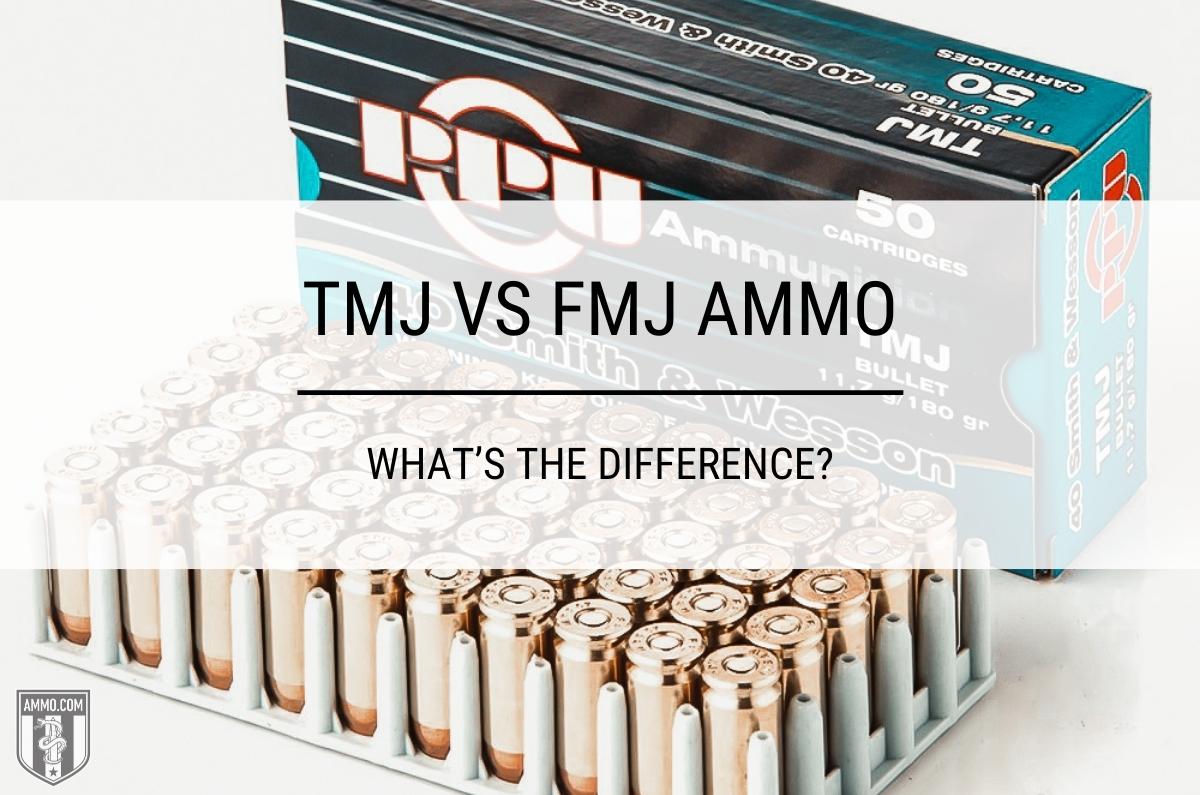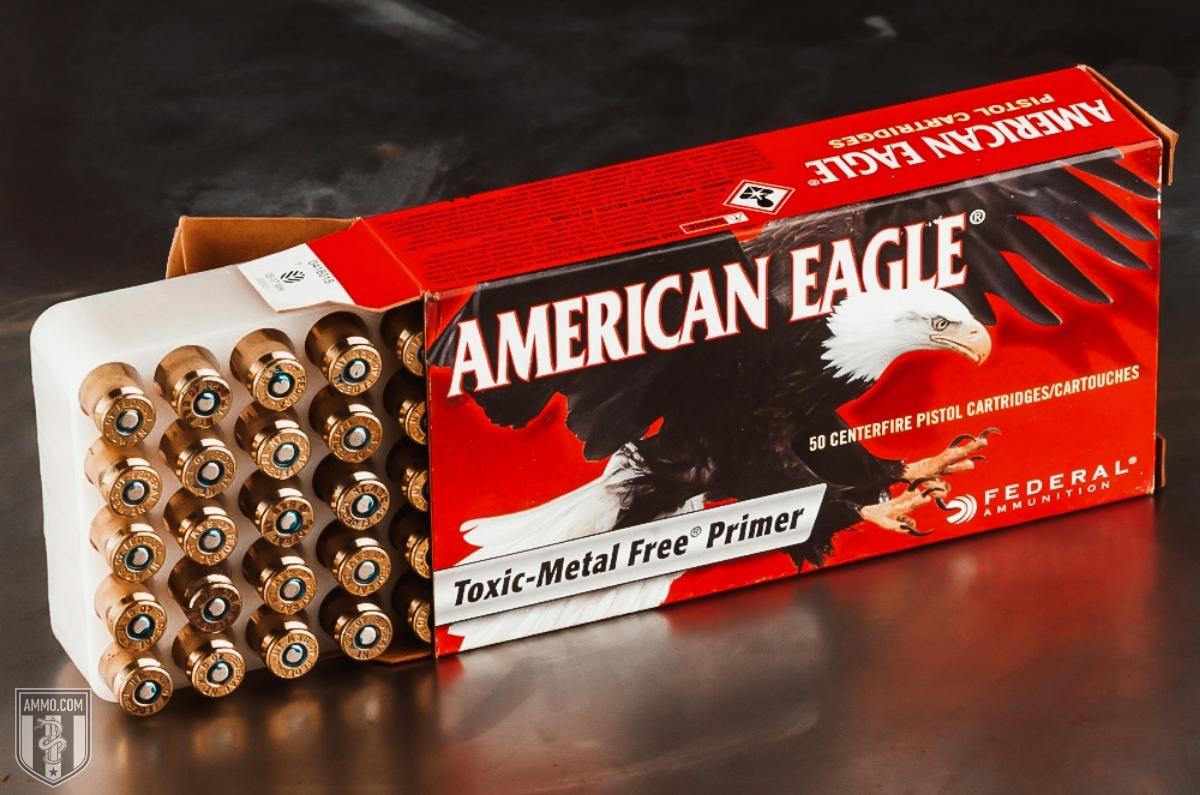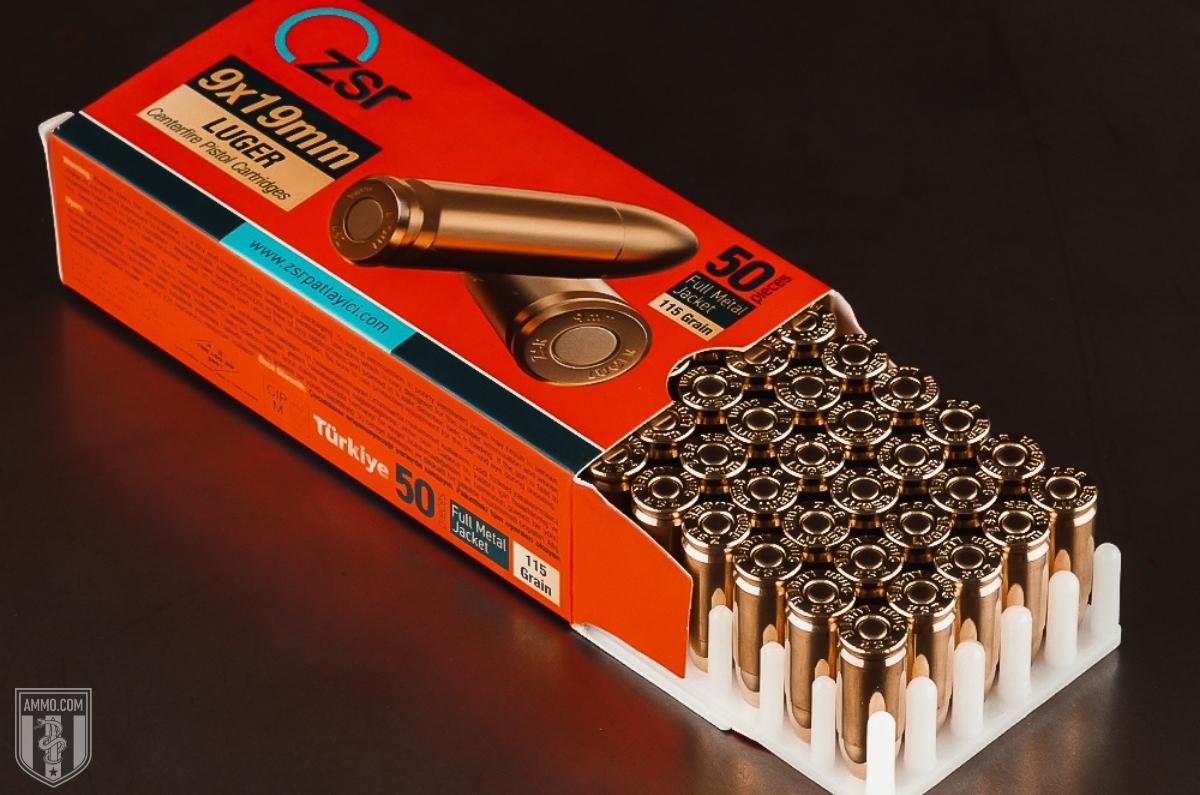TMJ vs. FMJ Ammo: What’s the Difference?

If you’ve only spent a short amount of time shopping for target ammo, then you have probably already encountered two types of it: full metal jacket (FMJ), and total metal jacket (TMJ).
The two bullets are named almost identically – but does that mean they’re the same?
No. Although FMJ and TMJ bullets share the same applications (plinking, training, and target shooting), the TMJ has a feature the FMJ lacks: one which minimizes lead aerosolization during ignition.
What’s the Key Difference Between the TMJ and FMJ?
The FMJ bullet’s metal jacket does not shield the base of its lead core against hot, exploding propellant gasses. An FMJ therefore emits toxic lead gas during ignition.
The TMJ bullet’s metal jacket completely envelops its lead core. When the base of the TMJ is exposed to hot propellant gasses, the lead beneath its jacket doesn’t evaporate.
What Is Full Metal Jacket Ammo (FMJ)?
The advent of firearms with internal loading mechanisms posed a new problem. Conventional lead bullets are relatively soft, and therefore inclined to deform when they are chambered mechanically (as opposed to by hand).

Swiss engineer Col. Eduard Rubin developed the solution around 1882: the FMJ, which consists of a dense lead core and surrounding metal jacket (typically copper alloy or steel). Its rigid jacket enables the FMJ to forgo deformation as it feeds into the chamber. The FMJ’s jacket also eliminates lead-on-bore contact, thereby conserving accuracy by slowing the rate of barrel fouling.
The FMJ fabrication process is straightforward. Take a cup-shaped copper jacket, insert a lead core into it, run the two through a swaging die so as to make their shape and weight distribution uniform, and voila – an FMJ. It’s an ideal bullet for cost-effective target shooting with nearly any type of handgun or rifle, and it also satisfies the Hague Convention of 1899 (which imposes a moratorium on the use of expanding bullets, e.g. hollow points, for humanitarian purposes).
Why Was the Total Metal Jacket (TMJ) Bullet Developed?
Although it is simple, practical, and economical, the FMJ can be argued to have one major design flaw: the base of its lead core, which isn’t jacketed.
Solid lead evaporates at a relatively low temperature for a metal (3,182 °F). Brief exposure to exploding propellant therefore evaporates lead off the base of an FMJ, which has four undesirable outcomes.
- An FMJ’s base becomes slightly distorted during ignition. When propellant gasses don’t have a flat, even surface to exert their energy against, accuracy can suffer as a result.
- An FMJ produces lead gas which accumulates inside an indoor range as dust or residue.
- An FMJ produces lead gas which accumulates inside the barrel. This fouling makes the bore’s rifling less effective at its job, and harms accuracy as a result.
- Lead gas is toxic. Exposure to lead inside gun ranges is unlikely to sicken a casual shooter, although serious marksmen, law enforcement professionals, and range staff are all at heightened risk of lead poisoning…
…if they endure long-term exposure to FMJ bullets within the confines of a stuffy, poorly ventilated gun range, that is. But if they attend a range that requires TMJ ammo – as many do – then they’re in much better standing. To understand why, ask yourself the big question:
What Is Total Metal Jacket Ammo (TMJ)?
A TMJ bullet is manufactured very differently than an FMJ. Essentially, a fully formed lead core is submerged in an electrified chemical bath. There it is electroplated: joined with copper one atom at a time until it is encapsulated by a uniformly thick jacket.
The base of the TMJ’s core is totally enveloped. The intense heat of ignition is therefore incapable of vaporizing lead, which promotes a cleaner and healthier indoor training environment. The TMJ helps to conserve accuracy and shorten cleaning time by decelerating the rate of barrel fouling. It can also promote better accuracy by giving propellant gasses a more uniform surface to push against (noting that most shooters cannot discern such a minute benefit). Its uniformly concentric jacket may also enhance the TMJ’s gyroscopic stability, which would only benefit its accuracy even further.
The TMJ’s electroplated jacket isn’t without its shortcomings. First, it costs more to fabricate, which is why TMJ ammo usually costs more than FMJ alternatives (albeit not by very much). Second, it is possible for a ported barrel or compensator to slice a thin sliver off of a TMJ’s jacket prior to expulsion from the muzzle. If that sliver deflects back toward the shooter’s face at high velocity … well, you obviously don’t want that to happen to you.
Is TMJ Ammo Good for Self-Defense?
No.

That’s not to say that a TMJ isn’t capable of neutralizing a threat in an instant. Its terminal ballistics are virtually identical to those of an FMJ, and the FMJ has remained the bullet of choice for international warfare for well over a century.
That said, the TMJ is suboptimal for personal defense for the same reason that the FMJ is. Neither bullet can undergo terminal expansion following impact with flesh – and you want expansion for three reasons:
Some high-quality hollow point ammo options would include Speer Gold Dot, Winchester PDX1, and Hornady Critical Defense.
- It increases the amount of kinetic energy transferred to the threat, which helps to neutralize the threat faster.
- It widens the diameter of the wound channel, which helps do the same.
- It reduces the risk of over-penetration that could jeopardize innocent bystanders positioned behind the threat.
The moral of the story? Use FMJ or TMJ ammunition for plinking, training and target practice, and favor the latter if you’re keen on minimizing your exposure to lead gas. (Take note that primers conventionally contain lead styphnate. Unless TMJ ammo’s packaging indicates otherwise, it is loaded with conventional primers.)
Conclusion: Is TMJ Better Than FMJ?
TMJ ammo is better in the sense that it reduces the shooter’s exposure to toxic lead, greatly diminishes lead fouling of the barrel, promotes a cleaner training environment, and potentially benefits accuracy.
Despite all these advantages, most shooters have little to gain by exclusively sticking to TMJ ammo. Unless you spend a lot of time haunting an indoor range, lead exposure resulting from ammunition is unlikely to make you sick. TMJ bullets may promote cleaner performance, but they by no means eliminate the need for cleaning. And if you’re firing handgun ammunition – which is meant for covering relatively short distances – then you are unlikely to appreciate the TMJ’s potential benefits for accuracy.
Here’s the most important thing you can take away from this article. It doesn’t matter if you want ammo loaded with FMJ, TMJ, JHP, HPBT, semi-wadcutter, HoneyBadger, or any other type of bullets. So long as it shoots, you should order it from Ammo.com!
Ammo Comparisons
- .308 vs 5.56
- 6.5 Creedmoor vs .308
- .300 Blackout vs .308
- .300 Win Mag vs .308
- .243 vs .308
- .308 vs .30-06
- 7mm-08 vs .308
- .270 vs .308
- 7.62x39 vs .308
- .223 vs .308
- .338 Lapua vs .308
- .380 ACP vs 9mm
- .223 vs 5.56
- .300 Blackout vs 5.56
- 9mm vs 45 ACP
- 9mm vs 40 S&W
- .357 SIG vs 9mm
- 10mm vs 9mm
- 9mm vs 9mm Luger
- .243 vs .270
- .300 Win Mag vs .30-06
- .270 vs .30-06
- .40 vs .45
- 38 Special vs 357
- 9mm vs 40 vs 45
- 5.56 vs 7.62x39
- 338 Lapua vs .30-06
- .30-30 vs .30-06
- 300 PRC vs 338 Lapua
- .30-06 vs 7mm
- 300 Win Mag vs 338 Lapua
- 300 PRC vs 300 Win Mag
- 300 WSM vs 300 Win Mag
- 338 Win Mag vs 338 Lapua
- 12 Gauge vs 20 Gauge
- 10mm vs 357 Mag
- .30-30 vs 7.62x39
- 224 Valkyrie vs 22-250
- 17 HMR vs 22 Mag
- 7.62x39 vs .300 Blackout
- 45 ACP vs 45 Auto
- 45-70 vs 30-30
- 300 Blackout vs 223
- 357 Magnum vs 9mm
- 350 Legend vs 300 Blackout
- 224 Valkyrie vs 223
- 45 ACP vs 38 Super
- 6.5 Grendel vs .308
- 17 HMR vs 22 LR
- 10 Gauge vs 12 Gauge
- 22-250 vs 223
- 45 Colt vs 45 ACP
- 350 Legend vs 30-30
- 5.7x28 vs 223
- 5.7 vs 9mm
- 5.56 vs 5.7
- 22 vs 9mm
- Buckshot vs Birdshot
- 450 Bushmaster vs 308
- 450 Bushmaster vs 223
- Buckshot vs Slug
- 6.5 Grendel vs 5.56 vs 223
- 6mm ARC vs 6.5 Grendel
- 44 vs 45
- 458 SOCOM vs 5.56
- 357 vs 44
- 32 ACP vs 380
- 300 Win Mag vs 338 Win Mag vs 338 Lapua Mag
- 450 Bushmaster vs 458 SOCOM vs 50 Beowulf
- 6mm Creedmoor vs 6.5 Creedmoor
- TMJ vs FMJ
- 44 Special Vs 44 Magnum
- 45 90 vs 45 70
- 6.8 Western vs 6.8 SPC
- 50 Beowulf vs 50 BMG
- 26 Nosler vs 6.5 PRC
- 28 Gauge vs 410
- 6.8 SPC vs 5.56
- 6.8 SPC vs 6.5 Grendel
- 6.8 Western vs 7mm Rem Mag vs .28 Nosler
- 6.8 Western vs 6.5 Creedmoor
- 22 Hornet vs 223
- 6.8 Western vs 6.5 PRC
- .410 vs 12 Gauge
- .410 vs 20 Gauge
- 22 LR vs 22 Mag
- 6mm ARC vs 243
- 7mm-08 vs 270
- 243 vs 6.5 Creedmoor
- Nickel vs Brass Casing
- 204 Ruger vs 223
- 50 Beowulf vs 5.56
- 260 Remington vs 6.5 Creedmoor
- 6mm Remington vs 243
- 28 Nosler vs 300 PRC
- 50 Beowulf vs 50 AE
- 22 Nosler vs 22-250
- 450 Marlin vs 45-70
- 300 Win Mag vs 300 Norma
- 458 SOCOM vs 300 Blackout
- 38-55 vs 45-70
- 22 Hornet vs 22 LR
- 300 Norma vs 338 Lapua
- 338 Lapua vs 50 BMG
- 28 Nosler vs 300 Win Mag
- 28 Nosler vs 6.5 Creedmoor
- 204 vs 22-250
- 458 SOCOM vs 45 70
- 44 40 vs 45 70
- 6.8 SPC vs 6.5 Creedmoor
- 450 Bushmaster vs 30-06
- 7mm Rem Mag vs 300 Win Mag
- 30 Carbine vs 223
- 25-06 vs 30-06
- 26 Nosler vs 28 Nosler
- 16ga vs 12ga
- 30 06 vs 7.62 x54R
- 9mm Makarov vs 9mm Luger
- 350 Legend vs 223
- 30 Carbine vs 5.56
- 6.5x55 vs 6.5 Creedmoor
- 6.5 Creedmoor vs 270 vs 25-06
- M193 vs M855
- 450 Bushmaster vs 458 SOCOM
- 6.5 Grendel vs 6.5 Creedmoor
- 350 Legend vs 5.56
- .277 Fury vs 6.8 SPC
- 277 Fury vs 300 Win Mag
- 10mm vs .45 ACP
- 277 Fury vs 223
- 6.8 SPC vs 300 Blackout
- 6.5 PRC vs 6.5 Creedmoor
- 277 Fury vs 308
- 277 Fury vs 6.5 Creedmoor
- 350 Legend vs 450 Bushmaster
- 277 Fury Vs 5.56 NATO
- 10mm vs 40S&W
- 32 ACP vs 9mm
- 32 Special vs 9mm
- 8.6 Blackout vs 300 Blackout
- 30 Super Carry vs. 9mm
- 5.56 vs 9mm
- .50 Action Express vs 9mm
- 7.62x25 vs. 9mm
- 10mm vs 44 Magnum
- 300 Blackout vs 300 Win Mag
- 6.5 Grendel vs 300 Blackout
- 460 Rowland vs 10mm
- 300 RUM vs 300 PRC
- 300 Norma vs 300 PRC
- 45 GAP vs 45 ACP
- 7mm PRC vs 300 Win Mag
- 300 PRC vs 6.5 Creedmoor
- 300 PRC vs 308
- 357 SIG vs 357 Mag
- 7.62x39 vs 7.62x51
- 243 Win vs 223 Rem
- 30 Nosler vs 300 PRC
- 6.5 Creedmoor vs. 30-06 Springfield
- 450 S&W vs. 44 Magnum
- 6.5 Creedmoor vs. 300 Win Mag
- 454 Cassull vs. 45-70 Govt
- 454 Cassull vs. 44 Mag
- 7.62x54r vs. 308 Winchester
- 22 ARC vs. 223 Rem
- Subsonic vs. Supersonic Ammo
